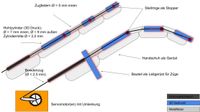EXOSKELETON FOR THE HUMAN HAND
May 2021
During a voluntary research project, my team and I aimed to build an exoskeleton for the human hand and gained first-hand experience in designing and building a cable-powered prototype.
Based on the analysis of current state-of-the-art approaches for powered exoskeletons for the hand, we specified the following different criteria and their requirements for an optimized solution:
- Minimal costs and high customization (design, manufacturing, price)
- Low weight and convenient wearing (design, weight)
- Low bulkiness and high accuracy of fit (design)
- Degrees of freedom for hand movement (all three joints) (mobility)
- Opposable thumb for grip movement (mobility)
- Rehabilitation or all-day application (battery runtime)
- Controlling of movements (communication interface)
- Adaption to biological restrictions of patients and safety
Used Parts
- Arduino NANO
- SunFounder PCA9685 16 Channel 12 Bit PWM Servo Driver for Arduino and Raspberry Pi
- SG90 Servo 5pack 9G Micro 180 Degree Servomotor
- Hootracker 6V 2400mAh NI-MH AA Rechargeable Battery Pack with SM-2P 2Pin Plug and USB Charger Cable
Our Prototype
The thumb should not be controlled for the time being, since it required a completely different mechanism than the other fingers. The connecting pieces between the joints were implemented as 3D-printed sleeves, to which the stoppers run and to which the springs are attached. This allows for easy interchangeability and the manufacture of sleeves of different sizes for different hands. There is also a 3D-printed end piece on the fingertips. The cables run on the back of the hand over a fastening and finally to the servos. The entire mechanism is mounted on a neoprene glove.
SG90-9g servos were chosen for the drive, as they provide a good ratio of power and weight. They are controlled via an Arduino Nano with an ATmega 328P processor and an external servo driver, which provides the necessary power for the servos. The Arduino also has the option of connecting additional input devices. An input interface via several buttons could thus be easily implemented. Two buttons stand for two different operating modes (close hand and open again / stretch hand and close again) and the third serves as an emergency stop. This was implemented in the Arduino as an interrupt so that this action can be called at any time during runtime.
The servos are controlled by means of pulse width modulation (PWM). Here the angle of the servo is controlled directly via the width of a square-wave signal. An example file recommended by the manufacturer of the servo driver was used as a template. The change in angle is mapped internally in a for loop, which gradually increases or decreases the width of the signal up to the defined end value. The start and end values can be adjusted to different servo motors by calibration. The values from the template are suitable for the servos used here.
Conclusion
An evaluation with a test subject has shown that there is still a need for optimization in some areas. The implementation of a technology that can be individually adapted to the patient also seems to be well applicable for this exoskeleton using 3D-printed parts. The electronics work reliably and can easily be supplemented with additional operating modes in the future. Also, no complex manufacturing processes or expensive materials were used and the neoprene glove ensures an acceptable wearing comfort. So in general, the project has been successful and has shown a possible way to implement a cable-powered hand exoskeleton.
